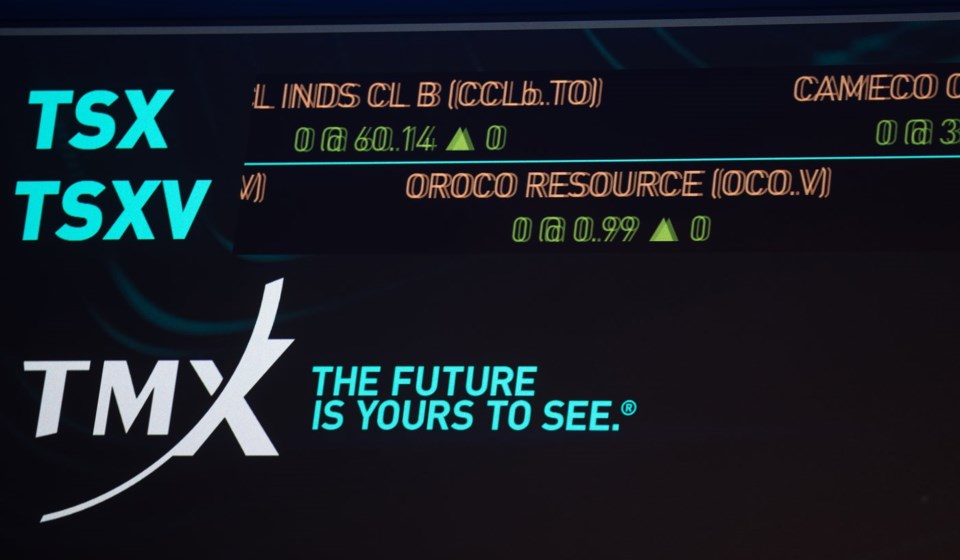Canada's main stock index fell more than one per cent Tuesday as it played catch-up while U.S. stock markets regained some of the ground lost in a big plunge Monday when the Toronto market was closed.
Wall Street suffered its worst day in nearly two years Monday after several weaker-than-expected economic reports raised worries that the U.S. Federal Reserve had pressed the brakes too hard for too long on the U.S. economy through high interest rates in order to beat inflation. That day, the S&P 500 lost three per cent, the Dow 2.6 per cent and the Nasdaq 3.4 per cent.
“Yesterday, the market had a bit of a temper tantrum,” said Ilana Schonwetter, investment advisor and portfolio manager at Blueshore Financial.
On Tuesday, the S&P/TSX composite index closed down 248.27 points at 21,979.36.
Meanwhile in New York, the Dow Jones industrial average was up 294.39 points at 38,997.66. The S&P 500 index was up 53.70 points at 5,240.03, while the Nasdaq composite was up 166.77 points at 16,366.85.
Markets in Asia also stabilized Tuesday, with Japan’s market recovering much of its losses from the day before after suffering its worst day since 1987.
Investors are increasingly concerned that a soft landing for the U.S. economy might not be guaranteed, said Schonwetter -- though she still thinks it’s the most likely scenario.
“The market has been letting off a little bit of steam for a couple of weeks now,” noted Schonwetter, as there’s been an ongoing rotation by investors away from the big tech names that have dominated market gains this year.
“If you look at the top performers, year to date, there's been such a concentration in the large mega cap stocks that I think we've come to a point now where there is a little bit of a rotation of institutional and retail money going a little bit out of that sector, taking some profits and shifting to (be) more diversified,” she said.
The concentration in the market of those big tech names amplified the selloff, said Schonwetter.
“The representation of those names makes up such a large part of the S&P 500 and the Nasdaq that when those names move down, obviously the impact on the index is very, very significant,” she said.
“Today, we are seeing the dust settle.”
Craig Basinger, chief market strategist at Purpose Investments, also says investors should refrain from interpreting the recent dramatic losses as a sign that the North American economy is tipping into recession.
"I wouldn't overreact to this," he said.
Though markets were already expecting the Fed to begin cutting rates in September, over the past few days, calls for a more aggressive approach have grown, said Schonwetter, whether that’s a bigger cut in September or a higher volume of cuts this year.
Markets are now pricing in about a 70-per-cent chance that the Fed will cut by 50 basis points in September, instead of just 25, according to data from CME Group.
Basinger said Monday’s selloff was largely triggered by technical factors, not broader economic conditions, with last week’s interest rate hike from the Bank of Japan affecting so-called “carry trades.” These trades, when investors borrow money in a low-interest-rate market and invest it in a higher-rate market, have been profitable recently, but an interest rate hike in Japan combined with softer U.S. economic data raising the likelihood of an aggressive rate cut by the Federal Reserve has changed that.
"I think there's just been a pretty big stampede towards the exit for this carry trade ... and that is what exacerbated a lot of the market moves and weird nuances that were going on yesterday," Basinger said.
Now the million-dollar question is whether Monday's market panic is over, or whether there is still more money that needs to come out, he said.
"I think you could possibly get some normalcy back in the market. The only risk, of course, is that these were really big moves — there could be some institutions that are sort of further offside now or in greater trouble."
The Canadian dollar traded for 72.50 cents US compared with 72.16 cents US on Friday.
The September crude oil contract was up 26 cents at US$73.20 per barrel and the September natural gas contract was up seven cents at US$2.01 per mmBTU.
The December gold contract was down US$12.80 at US$2,431.60 an ounce and the September copper contract was up three cents at US$4.03 a pound.
-- With files from The Associated Press
This report by The Canadian Press was first published Aug. 6, 2024.
Companies in this story: (TSX:GSPTSE, TSX:CADUSD)
Rosa Saba and Amanda Stephenson, The Canadian Press

